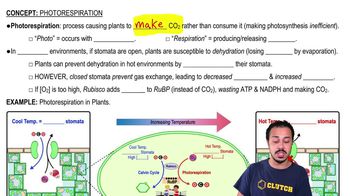Table of contents
- 1. Introduction to Biology2h 42m
- 2. Chemistry3h 40m
- 3. Water1h 26m
- 4. Biomolecules2h 23m
- 5. Cell Components2h 26m
- 6. The Membrane2h 31m
- 7. Energy and Metabolism2h 0m
- 8. Respiration2h 40m
- 9. Photosynthesis2h 49m
- 10. Cell Signaling59m
- 11. Cell Division2h 47m
- 12. Meiosis2h 0m
- 13. Mendelian Genetics4h 44m
- Introduction to Mendel's Experiments7m
- Genotype vs. Phenotype17m
- Punnett Squares13m
- Mendel's Experiments26m
- Mendel's Laws18m
- Monohybrid Crosses19m
- Test Crosses14m
- Dihybrid Crosses20m
- Punnett Square Probability26m
- Incomplete Dominance vs. Codominance20m
- Epistasis7m
- Non-Mendelian Genetics12m
- Pedigrees6m
- Autosomal Inheritance21m
- Sex-Linked Inheritance43m
- X-Inactivation9m
- 14. DNA Synthesis2h 27m
- 15. Gene Expression3h 20m
- 16. Regulation of Expression3h 31m
- Introduction to Regulation of Gene Expression13m
- Prokaryotic Gene Regulation via Operons27m
- The Lac Operon21m
- Glucose's Impact on Lac Operon25m
- The Trp Operon20m
- Review of the Lac Operon & Trp Operon11m
- Introduction to Eukaryotic Gene Regulation9m
- Eukaryotic Chromatin Modifications16m
- Eukaryotic Transcriptional Control22m
- Eukaryotic Post-Transcriptional Regulation28m
- Eukaryotic Post-Translational Regulation13m
- 17. Viruses37m
- 18. Biotechnology2h 58m
- 19. Genomics17m
- 20. Development1h 5m
- 21. Evolution3h 1m
- 22. Evolution of Populations3h 52m
- 23. Speciation1h 37m
- 24. History of Life on Earth2h 6m
- 25. Phylogeny2h 31m
- 26. Prokaryotes4h 59m
- 27. Protists1h 12m
- 28. Plants1h 22m
- 29. Fungi36m
- 30. Overview of Animals34m
- 31. Invertebrates1h 2m
- 32. Vertebrates50m
- 33. Plant Anatomy1h 3m
- 34. Vascular Plant Transport1h 2m
- 35. Soil37m
- 36. Plant Reproduction47m
- 37. Plant Sensation and Response1h 9m
- 38. Animal Form and Function1h 19m
- 39. Digestive System1h 10m
- 40. Circulatory System1h 57m
- 41. Immune System1h 12m
- 42. Osmoregulation and Excretion50m
- 43. Endocrine System1h 4m
- 44. Animal Reproduction1h 2m
- 45. Nervous System1h 55m
- 46. Sensory Systems46m
- 47. Muscle Systems23m
- 48. Ecology3h 11m
- Introduction to Ecology20m
- Biogeography14m
- Earth's Climate Patterns50m
- Introduction to Terrestrial Biomes10m
- Terrestrial Biomes: Near Equator13m
- Terrestrial Biomes: Temperate Regions10m
- Terrestrial Biomes: Northern Regions15m
- Introduction to Aquatic Biomes27m
- Freshwater Aquatic Biomes14m
- Marine Aquatic Biomes13m
- 49. Animal Behavior28m
- 50. Population Ecology3h 41m
- Introduction to Population Ecology28m
- Population Sampling Methods23m
- Life History12m
- Population Demography17m
- Factors Limiting Population Growth14m
- Introduction to Population Growth Models22m
- Linear Population Growth6m
- Exponential Population Growth29m
- Logistic Population Growth32m
- r/K Selection10m
- The Human Population22m
- 51. Community Ecology2h 46m
- Introduction to Community Ecology2m
- Introduction to Community Interactions9m
- Community Interactions: Competition (-/-)38m
- Community Interactions: Exploitation (+/-)23m
- Community Interactions: Mutualism (+/+) & Commensalism (+/0)9m
- Community Structure35m
- Community Dynamics26m
- Geographic Impact on Communities21m
- 52. Ecosystems2h 36m
- 53. Conservation Biology24m
34. Vascular Plant Transport
Water Potential
Problem 12b`
Textbook Question
Atmospheric CO₂ has been increasing rapidly since the late 1800s, largely due to human activities. Recall that CO₂ enters leaves through stomata and can then be used for photosynthesis. However, transpiration occurs as a result of water evaporating through stomata.
How have plants responded to elevated CO₂ levels?
What impact, if any, do you predict elevated CO₂ levels will have on the number of stomata in leaves and on the transpiration rate?
 Verified step by step guidance
Verified step by step guidance1
Understand the role of stomata: Stomata are small openings on the surface of leaves that allow for gas exchange. They are crucial for photosynthesis as they let CO2 enter the leaf, but they also allow water vapor to escape, which is known as transpiration.
Consider the effect of elevated CO2 levels: With increased atmospheric CO2, plants can potentially absorb more CO2 for photosynthesis. This might lead to changes in the number of stomata as plants adapt to the new conditions.
Predict changes in stomatal density: Research suggests that elevated CO2 levels can lead to a decrease in stomatal density. This is because plants may not need as many stomata to absorb the necessary CO2, reducing water loss through transpiration.
Analyze the impact on transpiration rate: With fewer stomata, the rate of transpiration may decrease. This is beneficial for plants as it helps conserve water, especially in environments where water is limited.
Consider the overall plant response: Plants may exhibit a range of responses to elevated CO2, including changes in growth patterns, photosynthetic efficiency, and water use efficiency. These adaptations help plants optimize their survival and growth in changing environmental conditions.
 Verified video answer for a similar problem:
Verified video answer for a similar problem:This video solution was recommended by our tutors as helpful for the problem above
Video duration:
4mPlay a video:
Was this helpful?
Key Concepts
Here are the essential concepts you must grasp in order to answer the question correctly.
Photosynthesis
Photosynthesis is the process by which plants convert light energy into chemical energy, using carbon dioxide and water to produce glucose and oxygen. Elevated CO2 levels can enhance photosynthesis, as more CO2 is available for the Calvin cycle, potentially increasing plant growth and productivity.
Recommended video:
Guided course

Pigments of Photosynthesis
Stomata
Stomata are small openings on the surface of leaves that allow for gas exchange, including the intake of CO2 for photosynthesis and the release of oxygen. They also facilitate transpiration, the process of water vapor loss. Changes in CO2 levels can influence stomatal density and behavior, affecting both photosynthesis and transpiration rates.
Recommended video:
Guided course

Photorespiration
Transpiration
Transpiration is the process by which water evaporates from plant leaves through stomata, helping to cool the plant and drive nutrient uptake. Elevated CO2 levels may lead to reduced stomatal density, potentially decreasing transpiration rates, as plants optimize water use efficiency in response to increased CO2 availability.
Recommended video:
Guided course

Water Potential in Soil and Air
Related Videos
Related Practice















































